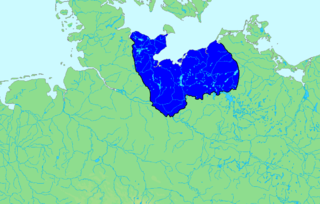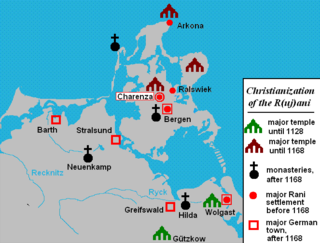
The Obotrites or Obodrites, also spelled Abodrites, were a confederation of medieval West Slavic tribes within the territory of modern Mecklenburg and Holstein in northern Germany. For decades, they were allies of Charlemagne in his wars against the Germanic Saxons and the Slavic Veleti. The Obotrites under Prince Thrasco defeated the Saxons in the Battle of Bornhöved (798). The still-Pagan Saxons were dispersed by the emperor, and the part of their former land in Holstein north of Elbe was awarded to the Obotrites in 804, as a reward for their victory. This however was soon reverted through an invasion of the Danes. The Obotrite regnal style was abolished in 1167, when Pribislav was restored to power by Duke Henry the Lion, as Prince of Mecklenburg, thereby founding the Germanized House of Mecklenburg.

Fehmarn is an island in the Baltic Sea, off the eastern coast of Germany's northernmost state of Schleswig-Holstein. It is Germany's third-largest island, after Rügen and Usedom. Fehmarn is separated from the German peninsula of Wagria in Holstein by the Fehmarn Sound, and from the southern Danish island of Lolland by the Fehmarn Belt. It is connected to the Holsatian mainland by the Fehmarn Sound Bridge. The island belongs to the district of Ostholstein. The closest larger towns on the mainland are Heiligenhafen and Oldenburg in Holstein. Right opposite Fehmarn, on the tip of the Wagrian Peninsula, is Großenbrode.

The Wendish Crusade was a military campaign in 1147, one of the Northern Crusades, led primarily by the Kingdom of Germany within the Holy Roman Empire and directed against the Polabian Slavs. The Wends were made up of the Slavic tribes of Abrotrites, Rani, Liutizians, Wagarians, and Pomeranians who lived east of the River Elbe in present-day northeast Germany and Poland.
Gottschalk, sometimes rendered as Godescalc, was a prince of the Obotrite confederacy from 1043 to 1066. He established a Polabian Slavic kingdom on the Elbe in the mid-11th century. His object in life seems to have been to collect the scattered tribes of the Slavs into one kingdom, and to make that kingdom Christian.

Polabian Slavs, also known as Elbe Slavs and more broadly as Wends, is a collective term applied to a number of Lechitic tribes who lived scattered along the Elbe river in what is today eastern Germany. The approximate territory stretched from the Baltic Sea in the north, the Saale and the Limes Saxoniae in the west, the Ore Mountains and the Western Sudetes in the south, and medieval Poland in the east.

The Veleti, also known as Veletians, Wilzi, Wielzians, and Wiltzes, were a group of medieval Lechitic tribes within the territory of Western Pomerania, related to Polabian Slavs. They had formed together the Confederation of the Veleti, also known as the Union of the Veleti, a loose monarchic confederation of the tribes. Said state existed between the 6th and 10th centuries, after which, it was succeeded by the Lutician Federation.

The West Slavs are Slavic peoples who speak the West Slavic languages. They separated from the common Slavic group around the 7th century, and established independent polities in Central Europe by the 8th to 9th centuries. The West Slavic languages diversified into their historically attested forms over the 10th to 14th centuries.
Kruto the Wend, son of Grin or Grinus, was a prince of Wagria. James Westfall Thompson believed his family belonged to the Rani of Rugia.
Henry was an Obotrite prince or king (1093–1127) from the Nakonid dynasty; he was regarded by contemporaries as "King of the Slavs". The Obotrite realm reached its greatest area during Henry's rule, extending from the Elbe to the Oder and from the Havelland to the Baltic Sea.

The Rani or Rujani were a West Slavic tribe based on the island of Rugia (Rügen) and the southwestern mainland across the Strelasund in what is today northeastern Germany.

Niklot or Nyklot was a chief or prince of the Slavic Obotrites and an ancestor of the House of Mecklenburg. He became chief of the Obotrite confederacy, including the Kissini and the Circipani, between the years 1130 and 1131. He remained in this position until his death in 1160. At the same time he was Lord of Schwerin, Quetzin and Malchow. For nearly 30 years he resisted Saxon princes, especially Henry the Lion during the Wendish Crusade.
The Nakonids were the leading noble family of the Slavic peoples of the Elbe River from ca. 960 until 1129. They were themselves of Obotrite origin and engineered the formation of a Slavic principality in the region. They became extinct in the male line in the early 12th century. Their capital was Mecklenburg Castle.
Henry of Badewide was a Saxon Count of Botwide and Count of Ratzeburg.
The Battle of Schmilau was a battle between a coalition of Christian forces and pagan Slavic Obotrites in 1093.

Liubice, also known by the German name Alt-Lübeck, was a medieval West Slavic settlement near the site of modern Lübeck, Germany. Liubice was located at the confluence of the Schwartau with the Trave across from Teerhof Island, approximately four kilometres north of Lübeck's island old town. The residence of Henry, the Christian prince of the Obotrites, Liubice was destroyed after his death by the Rani pagans of Rugia.
Bucu or Buku is a hill island surrounded by the Trave and Wakenitz Rivers in Lübeck, Germany. It is also the name of a medieval Slavic castle, now ruined, on the island. Count Adolf II of Holstein founded Lübeck on the island in 1143. The Burgkloster, or fortified monastery, of Lübeck is located atop the ruins of Bucu. "Bucu" is also the name of a hill.

The Prince-Bishopric of Ratzeburg was an ecclesiastical principality of the Holy Roman Empire that was located in what is today the states of Schleswig-Holstein and Mecklenburg-Vorpommern in Germany. It was established in 1236 and disestablished following the Peace of Westphalia in 1648. The state capital was the city of Ratzeburg. The Diocese of Ratzeburg had originally been established as a diocese of the Catholic Church in the 11th century but had fallen into abeyance; as a result of the Wendish Crusade, the diocese was re-created in the middle of the 12th century. The territory of the prince-bishopric was managed by secular lords on behalf of the Bishop of Ratzeburg. As a Prince-Bishopric of the Empire, the territory of the state was not identical with that of the bishopric, but was located within its boundaries and made up about a quarter of the diocesan area. When the Prince-Bishopric was disestablished, a new entity was established — the Principality of Ratzeburg. The principality became an exclave of the Duchy of Mecklenburg-Strelitz.

Wagria is the northeastern part of Holstein in the German state of Schleswig-Holstein, corresponding roughly to the districts of Plön and Ostholstein. The word "Wagria" is derived from the Slavic Lechites tribe of Wagri.

The Lutici or Liutizi(known by various spelling variants) were a federation of West Slavic Polabian tribes, who between the 10th and 12th centuries lived in what is now northeastern Germany. Four tribes made up the core of the federation: the Redarians, Circipanians (Circipani), Kessinians and Tollensians (Tholenzi). At least in part, the Lutici were a continuation of the Veleti. In contrast to the former and the neighboring peoples, the Lutici were not led by a Christian monarch or duke, rather power was asserted through consensus formed in central assemblies of the social elites, and the Lutici worshipped nature and several deities. The political and religious center was Radgosc.
The Slavic rebellion of 1066 was a pagan reaction to the spread of Christianity among the Obodrites. It was the third of three major pagan uprisings among the West Slavs against Christianity and its German supporters after the revolt of 983 and that of 1018. It was the most effective of the three.